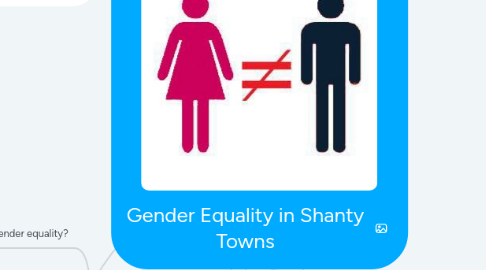
1. What makes people think that boys have more power than girls?
1.1. Traditions
1.2. Culture
1.3. Religion
2. When did gender inequality start?
3. Who had the idea of gender inequality?
4. Who is helping to stop gender inequality?
4.1. Shama Tina's Rav NGO is helping women in Rio De Janeiro to get a job: Sewing handbags & garments etc. using fish skin and leftovers from factories.
4.1.1. NGO started in 2006, trained 5000 women.
4.2. Malala spoke out for girls' education in the UN on her 16th birthday.
4.3. Malala Fund helps to raise awareness for girls to get education.
4.4. #HeForShe
4.5. United Nations
5. Introduction
5.1. What is gender equality?
5.1.1. Also known as sexual equality
5.1.2. A gender's identity/ how much power
5.2. What is gender inequality?
5.2.1. The discrimination of differences between genders.
5.2.2. Sometimes seen in shanty towns
6. How does gender equality impact people?
6.1. Malala almost got shot dead because she was speaking against the Taliban who did not want girls to go to school.
6.2. Fatima says that the Islamic rules almost control her life.
6.2.1. Must wear abaya and veil covering body + face.
6.2.2. No shaking hands with men.
6.2.3. No eating in public with men.
6.2.4. No feeding children in front of men.
6.2.5. No changing clothes in front of men.
6.2.6. No swimming in front of men.
6.2.7. No exercising on street.
6.2.8. No playing soccer with male.
6.2.9. No boyfriends.
6.2.10. No travelling alone.
7. Quotes
7.1. We need to make equal pay and equal opportunities for women and girls a reality so women's rights are human rights once and for all.---- Hillary Clinton
7.2. Gender equality is more than a goal in itself. It is a precondition for meeting the challenge of reducing poverty, promoting sustainable development and building good governess.---- Kofi Annan
8. Where does gender inequality exist the world? (In shanty towns)
9. What challenges are females facing?
9.1. Women's salary:Men's salary=19:25
9.2. 13,000,000,000 girls don't go to school
9.3. People in poverty: 1,000,000,000--70% (Female)
9.4. In a week, women work 5 hours more than men in Brazil.
9.5. People with no education: 64% (Female)
9.6. Scared to be laughed at to have their period at school
9.7. Girls have to go to school because there is clean water and toilets there.
9.8. In Saudi Arabia, women aren't allowed to drive.
9.9. Women in Saudi Arabia are not allowed to have jobs that are in contact with men.
9.10. The unemployment rate in Saudi Arabia for women to men is 33%:7%
9.11. 1/5 women are being sexually abused within the developing world.
9.12. In sub-Saharan Africa, Oceania and Western Asia, girls don't have the courage to go to primary and secondary school because of people laughing at them.
10. How can we help?
10.1. Stop all forms of sexual abuse.
10.2. Stop forced child marriage.
10.3. Let girls have the same education as boys.
10.4. Stop all unpaid labour.
10.5. Promote gender equality
10.6. Let female have access to reproductive care.
10.7. Let female have technological science education.
10.8. Give women equal public rights. E.g. Right to vote, to be a ruler etc.
11. Who is supporting gender inequality?
11.1. The Taliban
11.2. The Taliban thought that it was not right for girls like Malala to have education. So they shot Malala dead.
12. Who is being impacted because of gender inequality?
12.1. Malala
12.2. A lot of Islamic women
12.2.1. Fatima: age 23, Female, Sana'a, Yemen
13. Does gender inequality just mean that boys are more powerful than girls?
13.1. Usually seen that boys are more powerful than girls.
14. Key
14.1. Part 1: Challenges
14.1.1. Statistics + Challenges
14.1.2. Who is supporting gender inequality?
14.1.3. What are they doing to keep gender inequality going on?
14.1.4. Who is being impacted and why?
14.2. Introduction
14.3. Part 2: Solutions
14.3.1. Who is helping?
14.3.2. What are people doing to help?/ How can we help?
